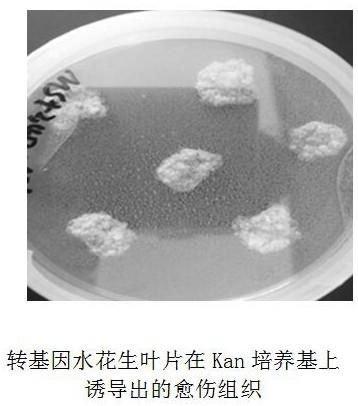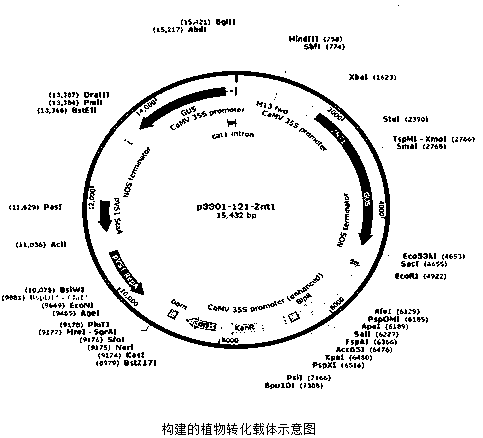Method for strengthening in-situ remediation of polluted water bodies in rivers and lakes by transgenic plants
A transgenic plant, in situ repair technology, applied in the field of river management and repair, can solve the problems of limited enrichment capacity and stress resistance of aquatic plants
- Summary
- Abstract
- Description
- Claims
- Application Information
AI Technical Summary
Problems solved by technology
Method used
Image
Examples
Embodiment 1
[0048] The method for in-situ remediation of polluted water bodies of rivers and lakes enhanced by transgenic plants, wherein the preparation method of transgenic plants is carried out according to the following steps:
[0049] 1. Establishment of plant tissue culture system
[0050] Take wild water peanut plants, wash them with clean water for 5-10 minutes, and cut off the shorter stems with germs and the shorter stems with axillary buds. Sterilize with 75% ethanol for 1 min and 1% NaClO for 8 min on a sterile operating table, wash the sterilized stems with sterile water 6-7 times, remove residual water on sterile filter paper, and then place them on the callus Tissue induction medium (MS+2mg / L2,4D+1mg / L6BA+20mg / L sucrose) and shoot induction medium (1 / 2 MS+2mg / L6BA+0.1mg / LNAA +30mg / L sucrose) culture medium , until it grows into callus and subculture seedlings (such as Figure 1-2 ). The stem segment with axillary buds was asexually propagated in a sterile environment as ...
Embodiment 2
[0062] The method for in-situ remediation of polluted water bodies in rivers and lakes enhanced by transgenic plants, the specific technical scheme is as follows:
[0063] 1. Transfer of nutrients and heavy metal elements in water and sludge
[0064] The water body is rehabilitated by using the transgenic plant water peanut, wherein, the exogenous gene that can enhance the heavy metal pollution efficiency of the plant and the exogenous gene that can improve the tolerance and accumulation of various metals is one of the following genes: ZNT1 gene, and the transgenic plant is One or more of the following plants: water peanut, reed, calamus, water hyacinth, hornwort, canna, water hyacinth, black algae, bitter grass, cress, and rush. Taking water peanut as an example, the optimal initial biomass is 2.6±0.05 g / m3.
[0065] 2. Combined with plant configuration through micro-terrain modification
[0066] Divide polluted river sections and lake landscapes, artificially construct ero...
Embodiment 3
[0071] A method for in-situ remediation of polluted water in rivers and lakes enhanced by transgenic plants:
[0072] 1. Select transgenic plants with basically the same growth, take transgenic Znt1 water peanuts as an example (about 20 cm in height), wash the root soil with distilled water, and move the plants into small black buckets containing polluted water, 3 plants per bucket, small The size of the barrel is 2 L, and each barrel contains 1.8 L of pure water (analytically pure). After 10 days of pre-cultivation, the transgenic plants were subjected to heavy metal treatment experiments with different gradients, Pb 2+ , Zn 2+ 、Cd 2+ The supply was from analytically pure Pb(NO 3 ) 2 , ZnSO 4 ∙7H 2 O and CdCl 2 ∙2.5H 2 O, the treatment without adding heavy metals was used as the control (CK1), and each treatment was repeated 3 times ( figure 1 ). Plants were harvested 2 weeks after treatment. Cut the plants short, wash them, and dry them at 45°C, take 0.2 g of plan...
PUM
 Login to View More
Login to View More Abstract
Description
Claims
Application Information
 Login to View More
Login to View More - R&D
- Intellectual Property
- Life Sciences
- Materials
- Tech Scout
- Unparalleled Data Quality
- Higher Quality Content
- 60% Fewer Hallucinations
Browse by: Latest US Patents, China's latest patents, Technical Efficacy Thesaurus, Application Domain, Technology Topic, Popular Technical Reports.
© 2025 PatSnap. All rights reserved.Legal|Privacy policy|Modern Slavery Act Transparency Statement|Sitemap|About US| Contact US: help@patsnap.com



